Psychology of Attachment: Behaviorist and Humanistic Approaches
VerifiedAdded on 2022/08/16
|8
|1898
|15
Essay
AI Summary
This essay provides a comprehensive overview of attachment theories, contrasting the behaviorist and humanistic perspectives. It begins by introducing the concept of attachment and its significance in early social development, referencing John Bowlby's attachment theory as a foundational framework. The essay then delves into the behaviorist perspective, exploring how attachment is viewed through the lens of nature, drawing on experiments by Konrad Lorenz (imprinting), Harry Harlow (monkey experiment), and others. The discussion then transitions to the humanistic perspective, focusing on nurture-based theories and the importance of personal experiences in shaping attachment. It references the work of Hodges and Tizard, as well as Bowlby's 44 thieves experiment to illustrate key points. The essay concludes by summarizing the key differences between the two theories and the potential consequences of insecure attachment, highlighting the importance of early childhood relationships for emotional and social development.
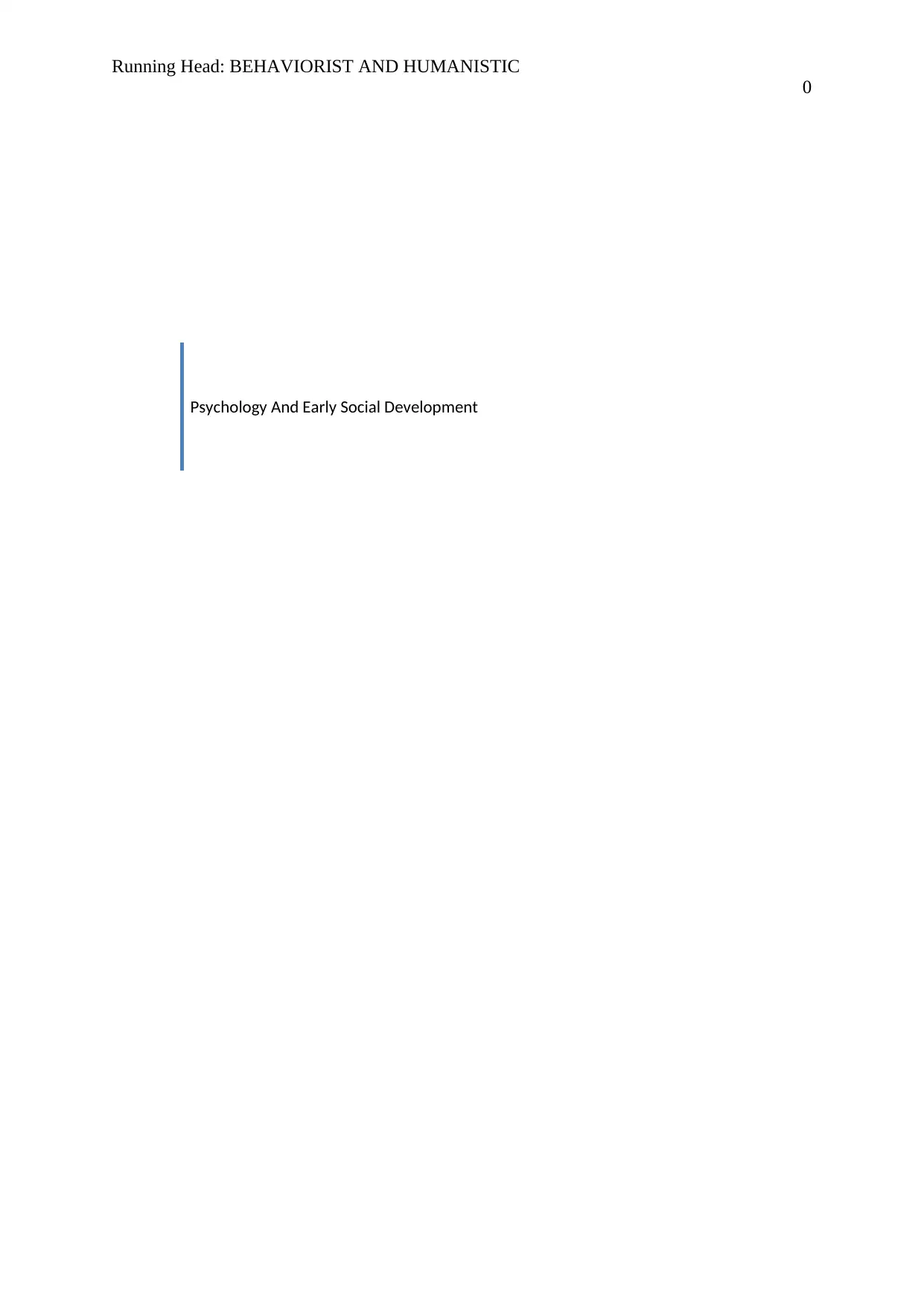
Running Head: BEHAVIORIST AND HUMANISTIC
0
Psychology And Early Social Development
0
Psychology And Early Social Development
Paraphrase This Document
Need a fresh take? Get an instant paraphrase of this document with our AI Paraphraser
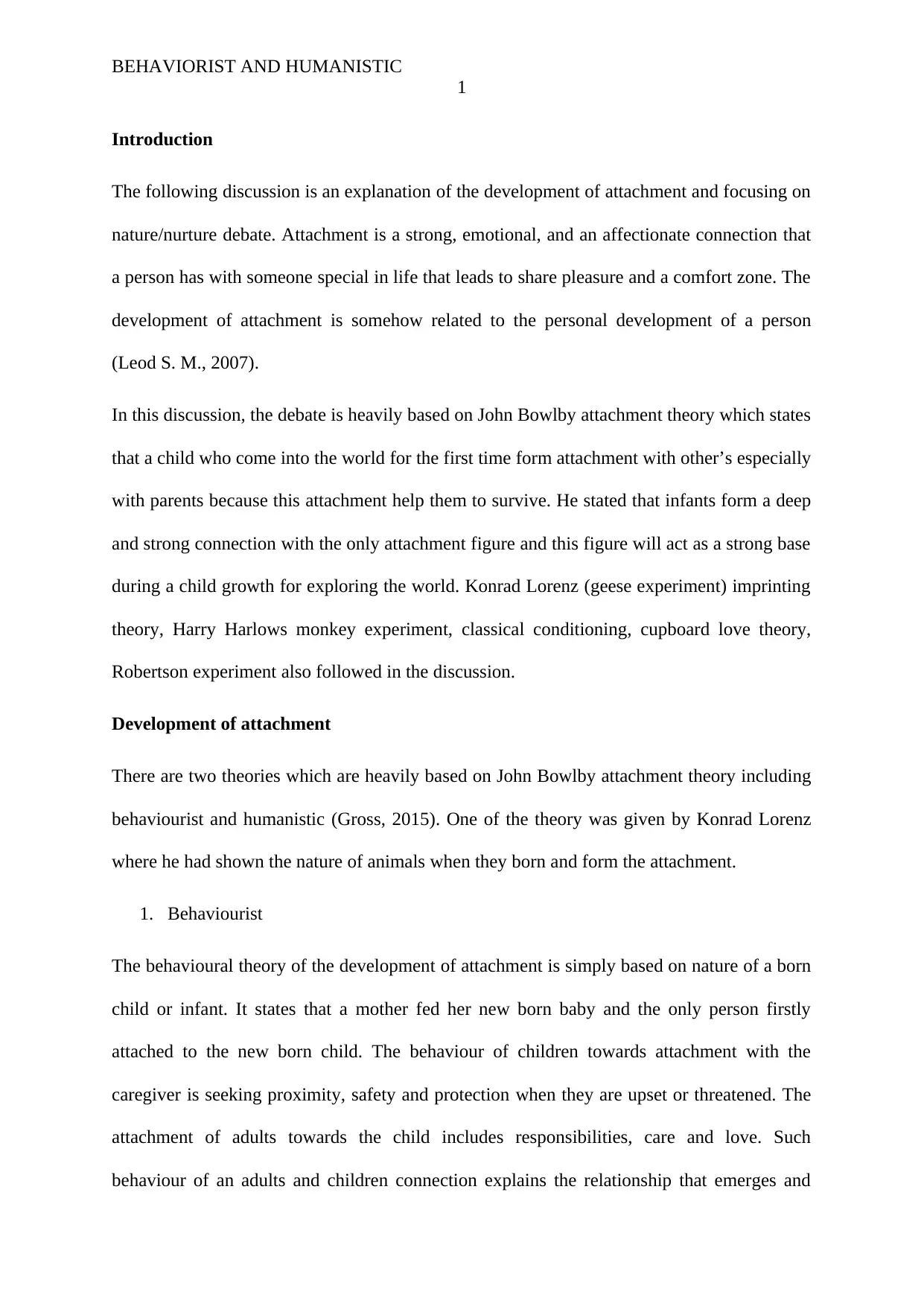
BEHAVIORIST AND HUMANISTIC
1
Introduction
The following discussion is an explanation of the development of attachment and focusing on
nature/nurture debate. Attachment is a strong, emotional, and an affectionate connection that
a person has with someone special in life that leads to share pleasure and a comfort zone. The
development of attachment is somehow related to the personal development of a person
(Leod S. M., 2007).
In this discussion, the debate is heavily based on John Bowlby attachment theory which states
that a child who come into the world for the first time form attachment with other’s especially
with parents because this attachment help them to survive. He stated that infants form a deep
and strong connection with the only attachment figure and this figure will act as a strong base
during a child growth for exploring the world. Konrad Lorenz (geese experiment) imprinting
theory, Harry Harlows monkey experiment, classical conditioning, cupboard love theory,
Robertson experiment also followed in the discussion.
Development of attachment
There are two theories which are heavily based on John Bowlby attachment theory including
behaviourist and humanistic (Gross, 2015). One of the theory was given by Konrad Lorenz
where he had shown the nature of animals when they born and form the attachment.
1. Behaviourist
The behavioural theory of the development of attachment is simply based on nature of a born
child or infant. It states that a mother fed her new born baby and the only person firstly
attached to the new born child. The behaviour of children towards attachment with the
caregiver is seeking proximity, safety and protection when they are upset or threatened. The
attachment of adults towards the child includes responsibilities, care and love. Such
behaviour of an adults and children connection explains the relationship that emerges and
1
Introduction
The following discussion is an explanation of the development of attachment and focusing on
nature/nurture debate. Attachment is a strong, emotional, and an affectionate connection that
a person has with someone special in life that leads to share pleasure and a comfort zone. The
development of attachment is somehow related to the personal development of a person
(Leod S. M., 2007).
In this discussion, the debate is heavily based on John Bowlby attachment theory which states
that a child who come into the world for the first time form attachment with other’s especially
with parents because this attachment help them to survive. He stated that infants form a deep
and strong connection with the only attachment figure and this figure will act as a strong base
during a child growth for exploring the world. Konrad Lorenz (geese experiment) imprinting
theory, Harry Harlows monkey experiment, classical conditioning, cupboard love theory,
Robertson experiment also followed in the discussion.
Development of attachment
There are two theories which are heavily based on John Bowlby attachment theory including
behaviourist and humanistic (Gross, 2015). One of the theory was given by Konrad Lorenz
where he had shown the nature of animals when they born and form the attachment.
1. Behaviourist
The behavioural theory of the development of attachment is simply based on nature of a born
child or infant. It states that a mother fed her new born baby and the only person firstly
attached to the new born child. The behaviour of children towards attachment with the
caregiver is seeking proximity, safety and protection when they are upset or threatened. The
attachment of adults towards the child includes responsibilities, care and love. Such
behaviour of an adults and children connection explains the relationship that emerges and
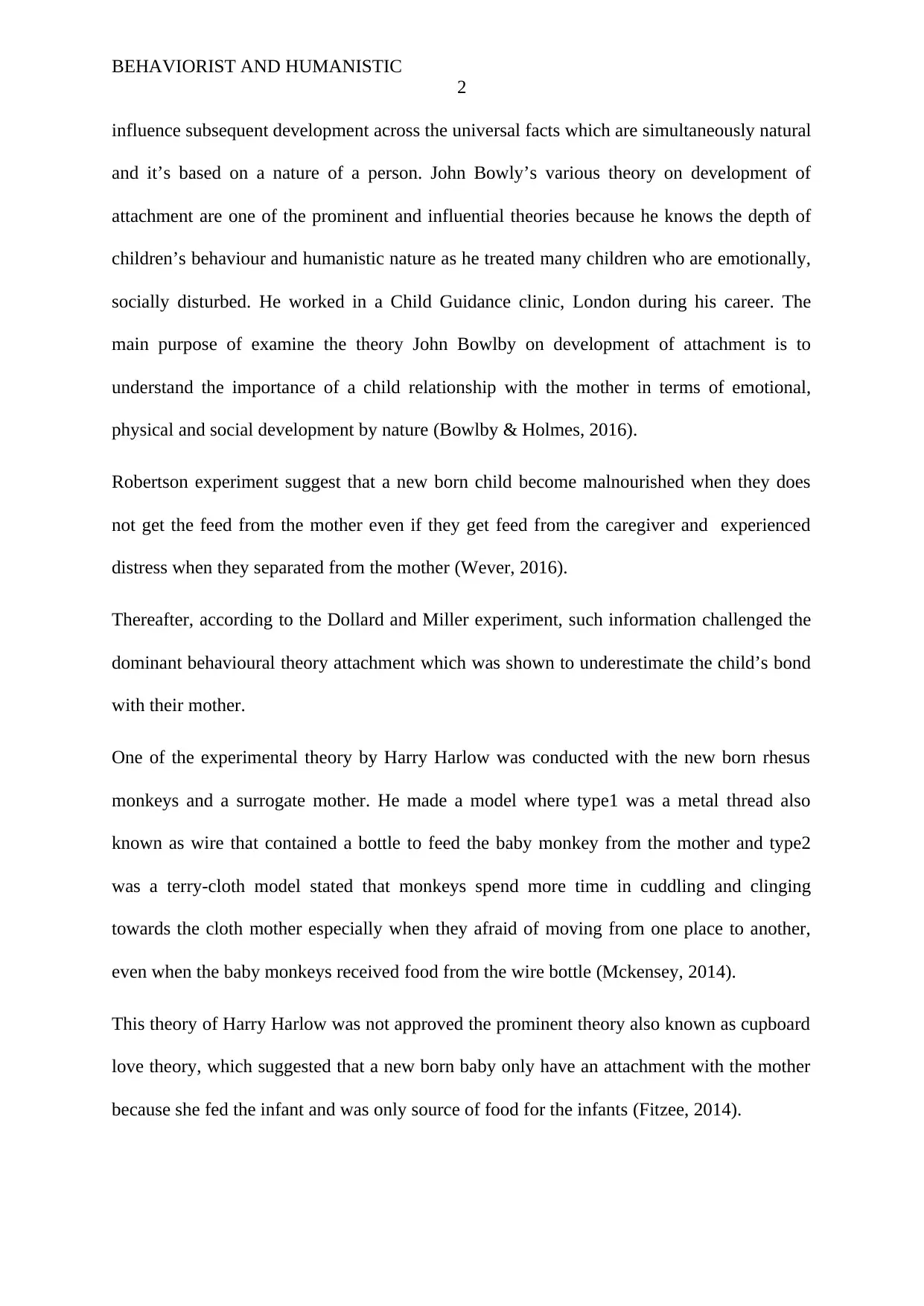
BEHAVIORIST AND HUMANISTIC
2
influence subsequent development across the universal facts which are simultaneously natural
and it’s based on a nature of a person. John Bowly’s various theory on development of
attachment are one of the prominent and influential theories because he knows the depth of
children’s behaviour and humanistic nature as he treated many children who are emotionally,
socially disturbed. He worked in a Child Guidance clinic, London during his career. The
main purpose of examine the theory John Bowlby on development of attachment is to
understand the importance of a child relationship with the mother in terms of emotional,
physical and social development by nature (Bowlby & Holmes, 2016).
Robertson experiment suggest that a new born child become malnourished when they does
not get the feed from the mother even if they get feed from the caregiver and experienced
distress when they separated from the mother (Wever, 2016).
Thereafter, according to the Dollard and Miller experiment, such information challenged the
dominant behavioural theory attachment which was shown to underestimate the child’s bond
with their mother.
One of the experimental theory by Harry Harlow was conducted with the new born rhesus
monkeys and a surrogate mother. He made a model where type1 was a metal thread also
known as wire that contained a bottle to feed the baby monkey from the mother and type2
was a terry-cloth model stated that monkeys spend more time in cuddling and clinging
towards the cloth mother especially when they afraid of moving from one place to another,
even when the baby monkeys received food from the wire bottle (Mckensey, 2014).
This theory of Harry Harlow was not approved the prominent theory also known as cupboard
love theory, which suggested that a new born baby only have an attachment with the mother
because she fed the infant and was only source of food for the infants (Fitzee, 2014).
2
influence subsequent development across the universal facts which are simultaneously natural
and it’s based on a nature of a person. John Bowly’s various theory on development of
attachment are one of the prominent and influential theories because he knows the depth of
children’s behaviour and humanistic nature as he treated many children who are emotionally,
socially disturbed. He worked in a Child Guidance clinic, London during his career. The
main purpose of examine the theory John Bowlby on development of attachment is to
understand the importance of a child relationship with the mother in terms of emotional,
physical and social development by nature (Bowlby & Holmes, 2016).
Robertson experiment suggest that a new born child become malnourished when they does
not get the feed from the mother even if they get feed from the caregiver and experienced
distress when they separated from the mother (Wever, 2016).
Thereafter, according to the Dollard and Miller experiment, such information challenged the
dominant behavioural theory attachment which was shown to underestimate the child’s bond
with their mother.
One of the experimental theory by Harry Harlow was conducted with the new born rhesus
monkeys and a surrogate mother. He made a model where type1 was a metal thread also
known as wire that contained a bottle to feed the baby monkey from the mother and type2
was a terry-cloth model stated that monkeys spend more time in cuddling and clinging
towards the cloth mother especially when they afraid of moving from one place to another,
even when the baby monkeys received food from the wire bottle (Mckensey, 2014).
This theory of Harry Harlow was not approved the prominent theory also known as cupboard
love theory, which suggested that a new born baby only have an attachment with the mother
because she fed the infant and was only source of food for the infants (Fitzee, 2014).
⊘ This is a preview!⊘
Do you want full access?
Subscribe today to unlock all pages.

Trusted by 1+ million students worldwide
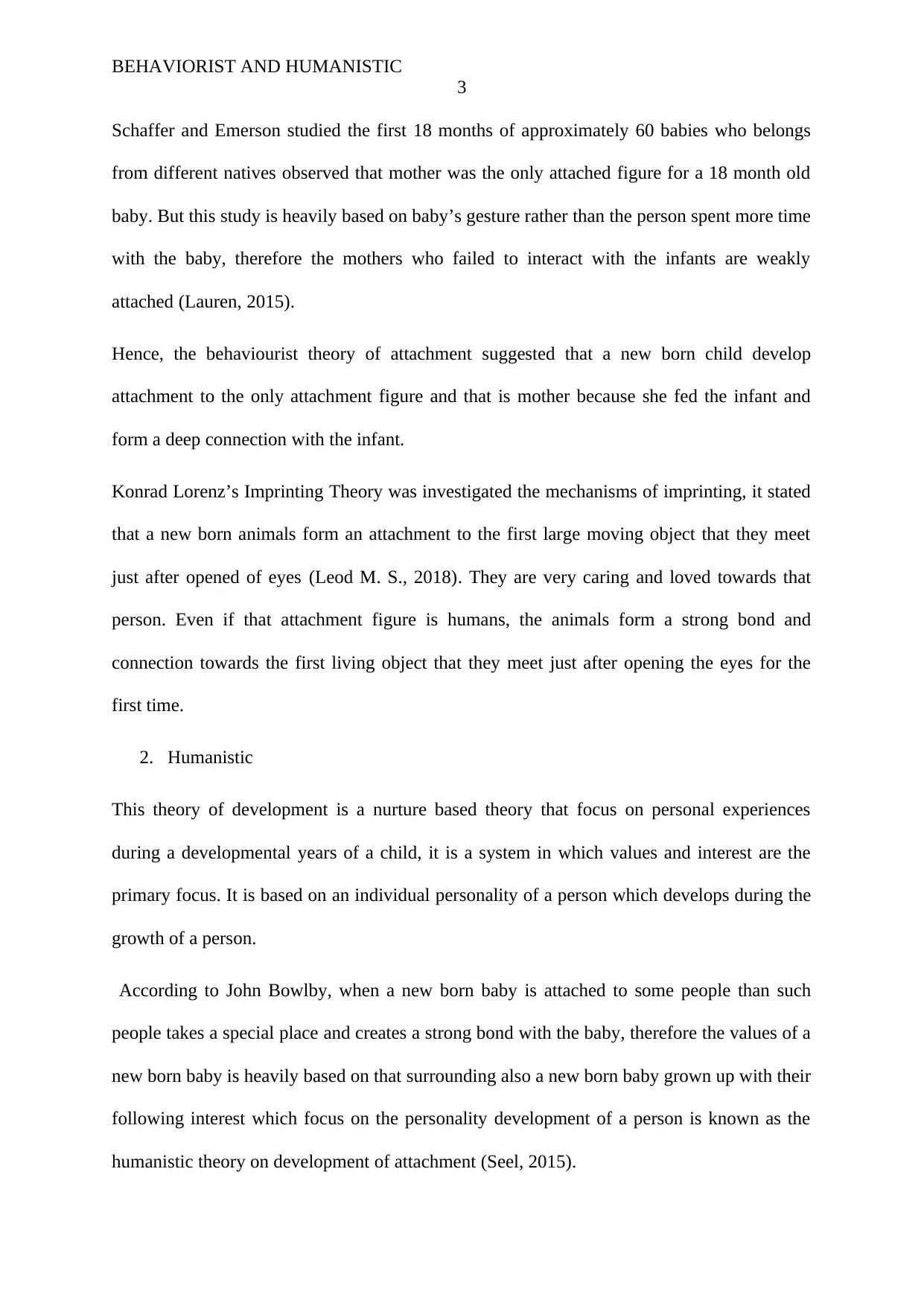
BEHAVIORIST AND HUMANISTIC
3
Schaffer and Emerson studied the first 18 months of approximately 60 babies who belongs
from different natives observed that mother was the only attached figure for a 18 month old
baby. But this study is heavily based on baby’s gesture rather than the person spent more time
with the baby, therefore the mothers who failed to interact with the infants are weakly
attached (Lauren, 2015).
Hence, the behaviourist theory of attachment suggested that a new born child develop
attachment to the only attachment figure and that is mother because she fed the infant and
form a deep connection with the infant.
Konrad Lorenz’s Imprinting Theory was investigated the mechanisms of imprinting, it stated
that a new born animals form an attachment to the first large moving object that they meet
just after opened of eyes (Leod M. S., 2018). They are very caring and loved towards that
person. Even if that attachment figure is humans, the animals form a strong bond and
connection towards the first living object that they meet just after opening the eyes for the
first time.
2. Humanistic
This theory of development is a nurture based theory that focus on personal experiences
during a developmental years of a child, it is a system in which values and interest are the
primary focus. It is based on an individual personality of a person which develops during the
growth of a person.
According to John Bowlby, when a new born baby is attached to some people than such
people takes a special place and creates a strong bond with the baby, therefore the values of a
new born baby is heavily based on that surrounding also a new born baby grown up with their
following interest which focus on the personality development of a person is known as the
humanistic theory on development of attachment (Seel, 2015).
3
Schaffer and Emerson studied the first 18 months of approximately 60 babies who belongs
from different natives observed that mother was the only attached figure for a 18 month old
baby. But this study is heavily based on baby’s gesture rather than the person spent more time
with the baby, therefore the mothers who failed to interact with the infants are weakly
attached (Lauren, 2015).
Hence, the behaviourist theory of attachment suggested that a new born child develop
attachment to the only attachment figure and that is mother because she fed the infant and
form a deep connection with the infant.
Konrad Lorenz’s Imprinting Theory was investigated the mechanisms of imprinting, it stated
that a new born animals form an attachment to the first large moving object that they meet
just after opened of eyes (Leod M. S., 2018). They are very caring and loved towards that
person. Even if that attachment figure is humans, the animals form a strong bond and
connection towards the first living object that they meet just after opening the eyes for the
first time.
2. Humanistic
This theory of development is a nurture based theory that focus on personal experiences
during a developmental years of a child, it is a system in which values and interest are the
primary focus. It is based on an individual personality of a person which develops during the
growth of a person.
According to John Bowlby, when a new born baby is attached to some people than such
people takes a special place and creates a strong bond with the baby, therefore the values of a
new born baby is heavily based on that surrounding also a new born baby grown up with their
following interest which focus on the personality development of a person is known as the
humanistic theory on development of attachment (Seel, 2015).
Paraphrase This Document
Need a fresh take? Get an instant paraphrase of this document with our AI Paraphraser
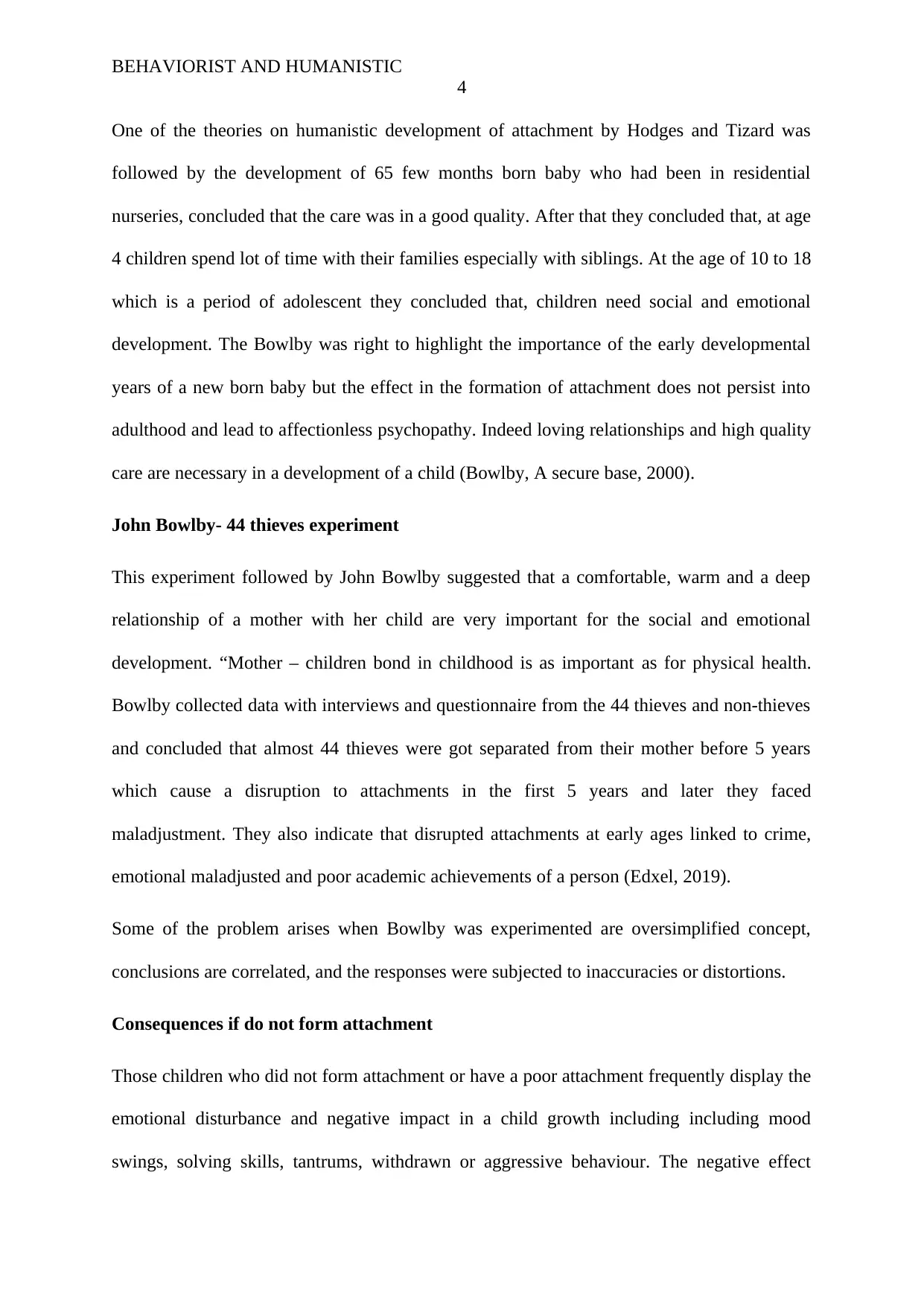
BEHAVIORIST AND HUMANISTIC
4
One of the theories on humanistic development of attachment by Hodges and Tizard was
followed by the development of 65 few months born baby who had been in residential
nurseries, concluded that the care was in a good quality. After that they concluded that, at age
4 children spend lot of time with their families especially with siblings. At the age of 10 to 18
which is a period of adolescent they concluded that, children need social and emotional
development. The Bowlby was right to highlight the importance of the early developmental
years of a new born baby but the effect in the formation of attachment does not persist into
adulthood and lead to affectionless psychopathy. Indeed loving relationships and high quality
care are necessary in a development of a child (Bowlby, A secure base, 2000).
John Bowlby- 44 thieves experiment
This experiment followed by John Bowlby suggested that a comfortable, warm and a deep
relationship of a mother with her child are very important for the social and emotional
development. “Mother – children bond in childhood is as important as for physical health.
Bowlby collected data with interviews and questionnaire from the 44 thieves and non-thieves
and concluded that almost 44 thieves were got separated from their mother before 5 years
which cause a disruption to attachments in the first 5 years and later they faced
maladjustment. They also indicate that disrupted attachments at early ages linked to crime,
emotional maladjusted and poor academic achievements of a person (Edxel, 2019).
Some of the problem arises when Bowlby was experimented are oversimplified concept,
conclusions are correlated, and the responses were subjected to inaccuracies or distortions.
Consequences if do not form attachment
Those children who did not form attachment or have a poor attachment frequently display the
emotional disturbance and negative impact in a child growth including including mood
swings, solving skills, tantrums, withdrawn or aggressive behaviour. The negative effect
4
One of the theories on humanistic development of attachment by Hodges and Tizard was
followed by the development of 65 few months born baby who had been in residential
nurseries, concluded that the care was in a good quality. After that they concluded that, at age
4 children spend lot of time with their families especially with siblings. At the age of 10 to 18
which is a period of adolescent they concluded that, children need social and emotional
development. The Bowlby was right to highlight the importance of the early developmental
years of a new born baby but the effect in the formation of attachment does not persist into
adulthood and lead to affectionless psychopathy. Indeed loving relationships and high quality
care are necessary in a development of a child (Bowlby, A secure base, 2000).
John Bowlby- 44 thieves experiment
This experiment followed by John Bowlby suggested that a comfortable, warm and a deep
relationship of a mother with her child are very important for the social and emotional
development. “Mother – children bond in childhood is as important as for physical health.
Bowlby collected data with interviews and questionnaire from the 44 thieves and non-thieves
and concluded that almost 44 thieves were got separated from their mother before 5 years
which cause a disruption to attachments in the first 5 years and later they faced
maladjustment. They also indicate that disrupted attachments at early ages linked to crime,
emotional maladjusted and poor academic achievements of a person (Edxel, 2019).
Some of the problem arises when Bowlby was experimented are oversimplified concept,
conclusions are correlated, and the responses were subjected to inaccuracies or distortions.
Consequences if do not form attachment
Those children who did not form attachment or have a poor attachment frequently display the
emotional disturbance and negative impact in a child growth including including mood
swings, solving skills, tantrums, withdrawn or aggressive behaviour. The negative effect
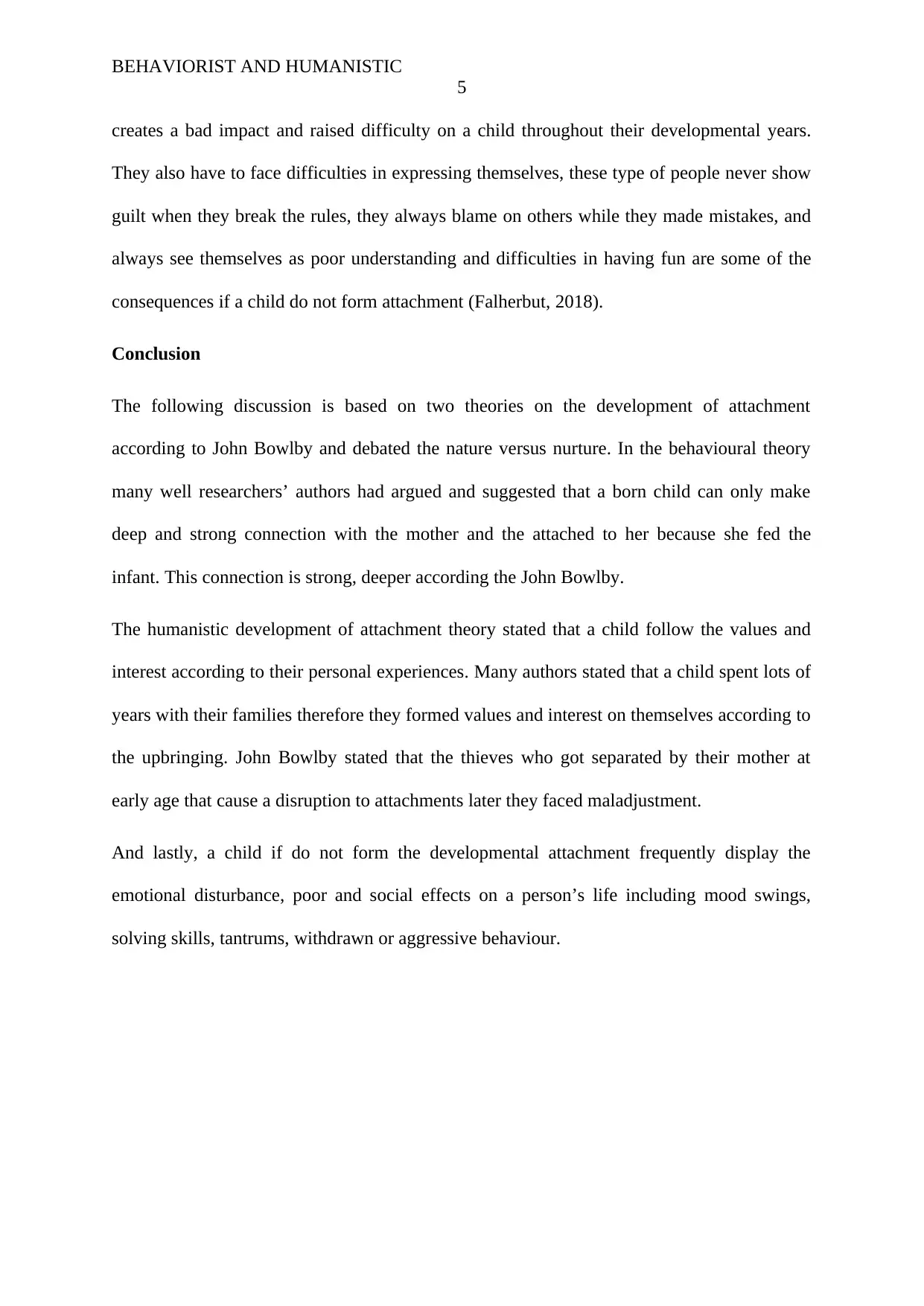
BEHAVIORIST AND HUMANISTIC
5
creates a bad impact and raised difficulty on a child throughout their developmental years.
They also have to face difficulties in expressing themselves, these type of people never show
guilt when they break the rules, they always blame on others while they made mistakes, and
always see themselves as poor understanding and difficulties in having fun are some of the
consequences if a child do not form attachment (Falherbut, 2018).
Conclusion
The following discussion is based on two theories on the development of attachment
according to John Bowlby and debated the nature versus nurture. In the behavioural theory
many well researchers’ authors had argued and suggested that a born child can only make
deep and strong connection with the mother and the attached to her because she fed the
infant. This connection is strong, deeper according the John Bowlby.
The humanistic development of attachment theory stated that a child follow the values and
interest according to their personal experiences. Many authors stated that a child spent lots of
years with their families therefore they formed values and interest on themselves according to
the upbringing. John Bowlby stated that the thieves who got separated by their mother at
early age that cause a disruption to attachments later they faced maladjustment.
And lastly, a child if do not form the developmental attachment frequently display the
emotional disturbance, poor and social effects on a person’s life including mood swings,
solving skills, tantrums, withdrawn or aggressive behaviour.
5
creates a bad impact and raised difficulty on a child throughout their developmental years.
They also have to face difficulties in expressing themselves, these type of people never show
guilt when they break the rules, they always blame on others while they made mistakes, and
always see themselves as poor understanding and difficulties in having fun are some of the
consequences if a child do not form attachment (Falherbut, 2018).
Conclusion
The following discussion is based on two theories on the development of attachment
according to John Bowlby and debated the nature versus nurture. In the behavioural theory
many well researchers’ authors had argued and suggested that a born child can only make
deep and strong connection with the mother and the attached to her because she fed the
infant. This connection is strong, deeper according the John Bowlby.
The humanistic development of attachment theory stated that a child follow the values and
interest according to their personal experiences. Many authors stated that a child spent lots of
years with their families therefore they formed values and interest on themselves according to
the upbringing. John Bowlby stated that the thieves who got separated by their mother at
early age that cause a disruption to attachments later they faced maladjustment.
And lastly, a child if do not form the developmental attachment frequently display the
emotional disturbance, poor and social effects on a person’s life including mood swings,
solving skills, tantrums, withdrawn or aggressive behaviour.
⊘ This is a preview!⊘
Do you want full access?
Subscribe today to unlock all pages.

Trusted by 1+ million students worldwide
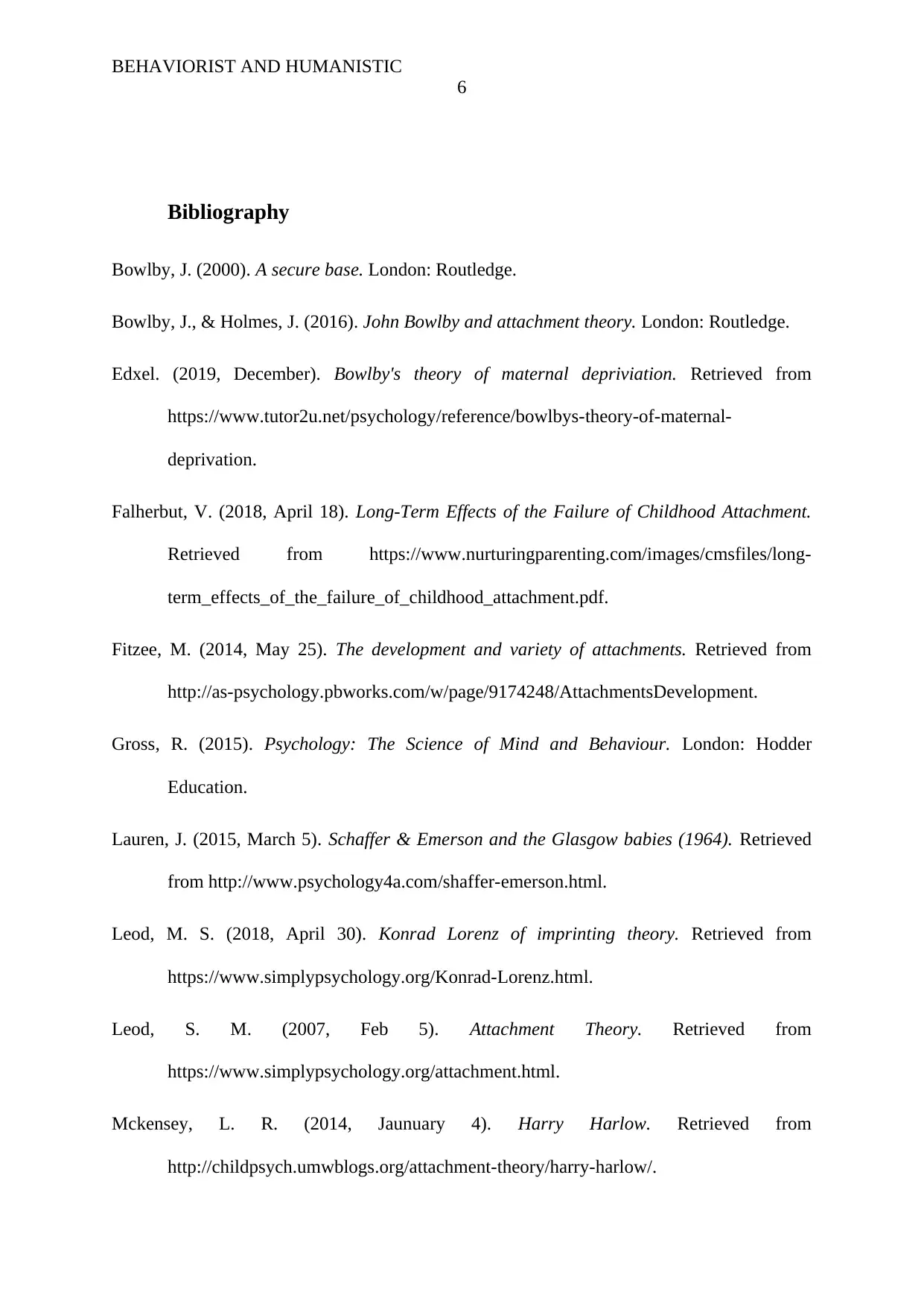
BEHAVIORIST AND HUMANISTIC
6
Bibliography
Bowlby, J. (2000). A secure base. London: Routledge.
Bowlby, J., & Holmes, J. (2016). John Bowlby and attachment theory. London: Routledge.
Edxel. (2019, December). Bowlby's theory of maternal depriviation. Retrieved from
https://www.tutor2u.net/psychology/reference/bowlbys-theory-of-maternal-
deprivation.
Falherbut, V. (2018, April 18). Long-Term Effects of the Failure of Childhood Attachment.
Retrieved from https://www.nurturingparenting.com/images/cmsfiles/long-
term_effects_of_the_failure_of_childhood_attachment.pdf.
Fitzee, M. (2014, May 25). The development and variety of attachments. Retrieved from
http://as-psychology.pbworks.com/w/page/9174248/AttachmentsDevelopment.
Gross, R. (2015). Psychology: The Science of Mind and Behaviour. London: Hodder
Education.
Lauren, J. (2015, March 5). Schaffer & Emerson and the Glasgow babies (1964). Retrieved
from http://www.psychology4a.com/shaffer-emerson.html.
Leod, M. S. (2018, April 30). Konrad Lorenz of imprinting theory. Retrieved from
https://www.simplypsychology.org/Konrad-Lorenz.html.
Leod, S. M. (2007, Feb 5). Attachment Theory. Retrieved from
https://www.simplypsychology.org/attachment.html.
Mckensey, L. R. (2014, Jaunuary 4). Harry Harlow. Retrieved from
http://childpsych.umwblogs.org/attachment-theory/harry-harlow/.
6
Bibliography
Bowlby, J. (2000). A secure base. London: Routledge.
Bowlby, J., & Holmes, J. (2016). John Bowlby and attachment theory. London: Routledge.
Edxel. (2019, December). Bowlby's theory of maternal depriviation. Retrieved from
https://www.tutor2u.net/psychology/reference/bowlbys-theory-of-maternal-
deprivation.
Falherbut, V. (2018, April 18). Long-Term Effects of the Failure of Childhood Attachment.
Retrieved from https://www.nurturingparenting.com/images/cmsfiles/long-
term_effects_of_the_failure_of_childhood_attachment.pdf.
Fitzee, M. (2014, May 25). The development and variety of attachments. Retrieved from
http://as-psychology.pbworks.com/w/page/9174248/AttachmentsDevelopment.
Gross, R. (2015). Psychology: The Science of Mind and Behaviour. London: Hodder
Education.
Lauren, J. (2015, March 5). Schaffer & Emerson and the Glasgow babies (1964). Retrieved
from http://www.psychology4a.com/shaffer-emerson.html.
Leod, M. S. (2018, April 30). Konrad Lorenz of imprinting theory. Retrieved from
https://www.simplypsychology.org/Konrad-Lorenz.html.
Leod, S. M. (2007, Feb 5). Attachment Theory. Retrieved from
https://www.simplypsychology.org/attachment.html.
Mckensey, L. R. (2014, Jaunuary 4). Harry Harlow. Retrieved from
http://childpsych.umwblogs.org/attachment-theory/harry-harlow/.
Paraphrase This Document
Need a fresh take? Get an instant paraphrase of this document with our AI Paraphraser
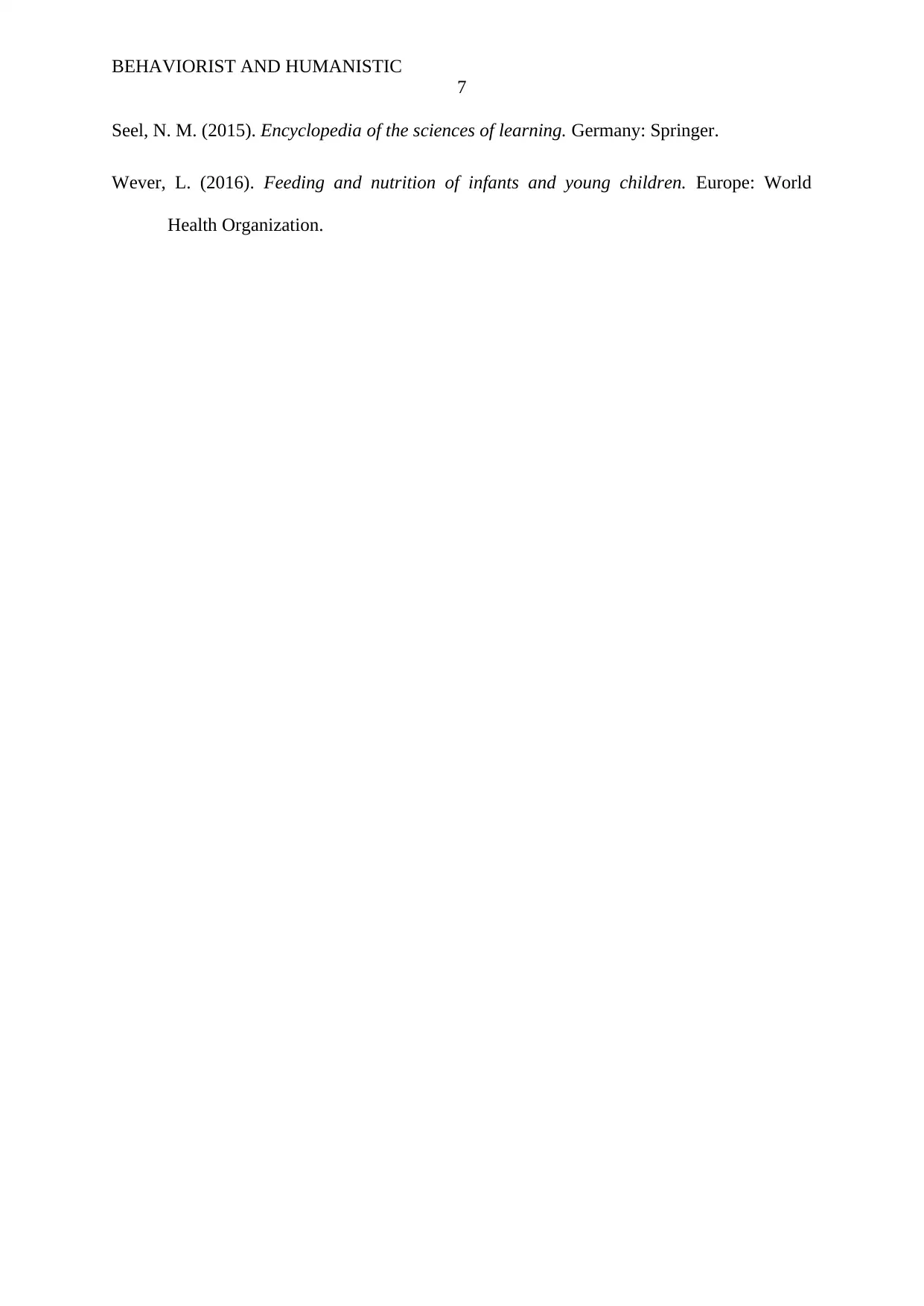
BEHAVIORIST AND HUMANISTIC
7
Seel, N. M. (2015). Encyclopedia of the sciences of learning. Germany: Springer.
Wever, L. (2016). Feeding and nutrition of infants and young children. Europe: World
Health Organization.
7
Seel, N. M. (2015). Encyclopedia of the sciences of learning. Germany: Springer.
Wever, L. (2016). Feeding and nutrition of infants and young children. Europe: World
Health Organization.
1 out of 8
Related Documents
Your All-in-One AI-Powered Toolkit for Academic Success.
+13062052269
info@desklib.com
Available 24*7 on WhatsApp / Email
![[object Object]](/_next/static/media/star-bottom.7253800d.svg)
Unlock your academic potential
Copyright © 2020–2025 A2Z Services. All Rights Reserved. Developed and managed by ZUCOL.





